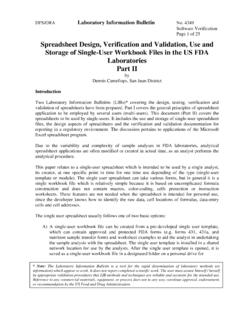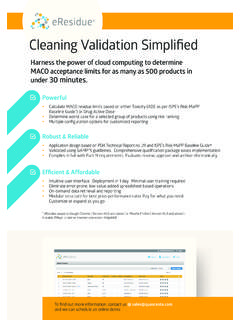Transcription of Challenges in database design with Microsoft Access
1 Journal of Instructional Pedagogies Volume 15 - October, 2014 Challenges in database , Page 1 Challenges in database design with Microsoft Access Jerzy Letkowski Western New England University ABSTRACT design , development and explorations of databases are popular topics covered in introductory courses taught at business schools. Microsoft Access is the most popular software used in those courses. Despite quite high complexity of Access , it is considered to be one of the most friendly database programs for beginners. A typical Access textbook teaches students first how to design and build databases. Next the students are exposed to forms, reports and queries. Advanced courses also delve into applications of modules and macros. In many database design situations, separation of a logical data model from its physical implementation is necessary. Nontechnical, subject-matter, experts and end-users can better understand the logical data model and thus they can help improve the model s structure.
2 This paper focuses on the database design phase. It shows a database design cases implemented in MySQL Workbench and in Microsoft Access . It also attempts to expose some difficulties and anomalies that may be encountered when using exclusively Microsoft Access . Alternative logical- design solutions are also presented. Keywords: database , design , data model, table, relationship, query, UML. Copyright statement: Authors retain the copyright to the manuscripts published in AABRI journals. Please see the AABRI Copyright Policy at Journal of Instructional Pedagogies Volume 15 - October, 2014 Challenges in database , Page 2 database design PROCESS A typical database design process involves requirement analysis, conceptual (high level) design , and logical design all leading to a physical design (Elmasri, at al., 2004, p. 51). The final logical data model should be specific enough in order to be mapped onto a physical database .
3 As shown, for example, in (Letkowski, 2014), a data model developed as an Enhanced Entity Relationship Diagram (EERD) in MySQL Workbench can be automatically transformed into a physical design ( database schema). Such a model includes a complete set of entities, attributes, key, relationships, cardinality and participation constraints that are necessary to accurately define a physical database (Silberschatz, at al., 2001, p. 27-37). Building a data model (EERD), using systems like MySQL Workbench, depends more on the subject-matter (domain) expertise than on the database skills. A subject-matter expert, who understands simple concepts of an entity (or class) and relationship can decidedly contribute to development of the data model. The following example shows a simulated scenario1 of the database design process with two participants: a domain expert (a sales manager, Mark ) and database expert (a database administrator, Debbie ).
4 Mark: I have been managing my sales for quite some time, using a phone and spreadsheet based ordering system. Recently, I have read some interesting articles about how my job can be improved by switching to a Web based system. Debbie: You understand that a Web system requires a multiuser and concurrent Access to your data! Thus you can t use your spreadsheet program. You would have to move to a database solution. Mark: Yes, I have read about that too. Can you help me with designing a database ? I d like to see, for example, how basic information about customers, orders and products can be stored in the database . Debbie: Absolutely! Could you briefly explain how your system works? At this stage, let s us focus on capturing and modeling information about orders. Mark: It is quite simple. We maintain a list of customers and products. Our customers place orders from time to time. We make sure that each order belongs to one and only one customer.
5 The orders include some of our products mainly small pieces of furniture (desks, chairs, shelves, etc.). Each product may be part of many orders. Debbie: I get it! Would you agree that your basic data entity sets (or object sets) are: Customer, Order and Product? Mark: Indeed they are! As a matter of fact they are already maintained in our current system as spreadsheet lists. Our customers are mainly businesses so we store name , addresses , contact information ( phone , fax , and email ). Our orders includes order date and reference to the customers who placed them ( cid ). Finally, our products are characterized using such properties as description , finish , unit price , and quantity on hand . Debbie: Great! You can also say that they (entity sets) are organized as tables. If so, they will be organized in a database in almost the same way as database tables. We have to make sure that all rows in the tables are unique.
6 To this end, for each table, we will create an identifier that, as you probably know, is referred to as a Primary Key (PK). Mark: I thought it would be much harder. In fact, we use integers to identify particular rows in the spreadsheet tables so we could easily look up relevant data, for example, when generating invoices. Our identifiers are: cid (customer ID), poid (Order ID), and pid (Product ID). 1 This scenario is loosely based on the Pine Valley Furniture case presented in (Hoffer, at al., 2005 p. 63-70). Journal of Instructional Pedagogies Volume 15 - October, 2014 Challenges in database , Page 3 Debbie: Outstanding! Indeed, a spreadsheet lookup procedure comes very close to what we refer to in a database as a relationship. Later, in the database , you will be able to generate invoices by just using relationships, speaking of which, you have already mentioned the most important ones.
7 Let me formalize them, using already established entity sets, as: <Customer(1) places Order( )> <Order( ) includes Product( )> Mark: I kind of get it but not entirely. Debbie: The first relationships is of type one-to-many . As you mentioned, a customer may place one or many orders ( ). In the same time, each order belongs to one (1) and only one customer. The second relationship is of type many-to-many . One order may include many products ( ) and one product may be part of zero or many orders ( ). These entities and relationships plus the attributes you mentioned above are all we need to construct a data model the so called Entity Relationship Diagram (ERD). I will show you how to do it, using the 2014 version of MySQL Workbench2. The first step is to define the basic entities: Customer, Order and Product. Start MySQL workbench, create a new EERD model and, using the Table tool add the three entities, providing their names and attributes.
8 Make sure that each entity has its own PK (Primary Key). Figure 1 shows the resulting diagram. Notice that, contrary to a spreadsheet implementation, each of the attributes must have appropriate type. The generic types (INT, FLOAT, DATETIME) are obvious. VARCHAR and CHAR stand for text types. The former speciffies the maximum size (capacity) and the latter the exact size. Next, the relationships between the entities must be defined. They are a reflection of business. The Customer - Order relationship is created, using a Non-Identifying, One-To-Many relationship (1:n) by and connecting entity Order with entity Customer. A new attribute is added automatically to entity Order: Customer_cid (Figure 2). Mark: Why is the Non-Identifying Relationship used here? What does it mean? Debbie: Both the entities (Customer and Order) are already identified by their primary keys (cid, and poid). The additional field, Customer_cid, added to entity Order does not uniquely identify any order.
9 It simply points to the customers that own the orders. Mark: It makes sense. What about the new attribute, Customer_cid? It looks like a copy of the primary key cid in entity (table) Customer. In our spreadsheet implementation we use a similar approach in order to be able to lookup customer information in our invoices. Debbie: Indeed it acts like a copy. Such an attribute is called a Foreign Key (FK). Its role is to make sure that each order knows its owner. One can also say that each order matches (Harkins, 2004) its customer. In addition, the database system should ensure that each value of this attribute is one of the values of the related primary key, cid defined in table Customer. This kind of validation is referred to as Referential Integrity. It is also important to note that this new key, Customer_cid, is strictly connected to the relationship between entities Order and Customer. Removing the key will also remove the relationship (connection line) and vice versa.
10 It is very important to understand that a foreign key only exists in the context of a relationship. It is a property of an entity (table) whose instances (records) depend on or are spawn by an instance of the related entity. with respect to the Customer Order relationship, a customer places (creates) one or more orders. Each order is signed by one customer. This signature is represented by the foreign key. 2 A complete (detail) procedure for developing a data model (EERD), using MySQL Workbench is shown in (Letkowski, 2014). Journal of Instructional Pedagogies Volume 15 - October, 2014 Challenges in database , Page 4 Mark: OK, I got it! The PK-FK pairs reflect particular relationship instances which arise from business operations (rules). I could say that the role of the Primary Key is to maintain the Entity Integrity and the role of the Foreign Key is to ensure the Referential Integrity.
















